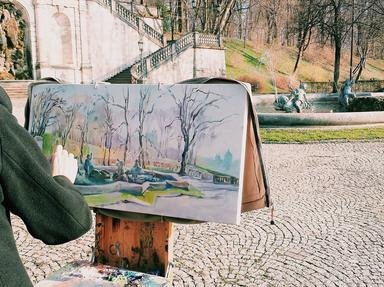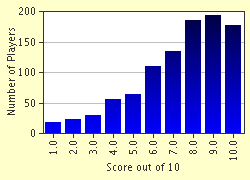Quiz Answer Key and Fun Facts
1. This painting is a large fresco that is hanging in the entrance to my study. It has faded over time since it is about 500 years old, and it may have been damaged slightly since the time that Uncle Filbert had it moved from its original location near Milan, Italy. The artist was probably left handed, and although the dogs are mostly playing cards, one in the corner appears to be playing with a helicopter-like toy. The beagle in the center probably has a good hand judging from her enigmatic smile. Who most likely painted the masterpiece on which the described "Dogs Playing Poker" work would have been based?
2. This painting shows the interior of a late Nineteenth Century cardroom. A window to the outside shows a park on an island. Upon closer inspection, one can see that the painting really consists of thousands of tiny dots of color which, when seen from a distance, produces a very pleasing effect. One art critic has claimed that this is the most spectacular Neo-Impressionist canine card-game painting anywhere. Most of the dogs playing are poodles and French bulldogs except for an odd looking dog on a leash that looks a lot like a monkey. Wait a minute -- that is a monkey. Anyway, who do you believe painted the piece of art on which the described "Dogs Playing Poker" work was based?
3. This work is a Nineteenth Century woodcut believed to be part of a group of thirty-six views of the Edo dog pound. The dogs playing poker in this work appear to be mostly Shiba Inus and Akitas. The work consist of simple lines and bright colors, except for a water dish where the water splashing around in the bowl forms a menacing wave. Which artist have my appraisers decided is the creator of the piece of art on which the described "Dogs Playing Poker" work was based?
4. This painting was produced by a Seventeenth Century Baroque Flemish artist. All the dogs in this scene have folded their hands except for two spaniels that are still in the pot. It is believed that one the dogs is modeled after the Archduchess Isabella of Spain's pet, and the other is modeled after the dog owned by King Charles I of England. All the other dogs seem to be slightly fatter than average. Who most likely painted the canvas that inspired the described "Dogs Playing Poker" work?
5. This painting is probably the most controversial work in this collection. I believe that it is part of a famous quadtych, the rest of which is on display at the Prado museum in Spain. Others disagree, claiming that dogs playing poker is inconsistent with the horrific images on the rest of "The Garden of Earthly Delights." Many art historians have asked me what is so horrific in the painting that I have, to which I answer, "The dog on the left is drawing to an inside straight!" So, whose work do I believe that the described "Dogs Playing Poker" work was based on a portion of?
6. A poster from a Parisian nightclub known as the Moulin Pooch. A poker game is taking place in the back room between chihuahuas, silky terriers, dachshunds, and other dogs with very short legs drinking absinthe while playing. The composition of the poster is very asymmetric with flat areas of color. Who produced the poster on which the described "Dogs Playing Poker" work was based?
7. This painting is my personal favorite. Although the dogs are also drinking absinthe in this painting, unlike the previous painting every square inch of this oil on canvas is covered with layers of striking colors. Sometimes the paint is layered so thick that it actually bulges out away from the picture. It is believed that the artist painted this work while in a sanitarium in San Remy. I believe one hound in the painting chewed off his ear because he was bluffed out of a big pot by a pair of threes. Others say he chewed off the ear because some woman left him. Who painted the work on which the described "Dogs Playing Poker" work was based?
8. This painting appears to be a collage of different styles that this painter used during his 92 year life. We see a German Shepherd folding his hand (paw?) that seems representative of this artist's blue period. Next is a Saint Bernard that appears to be representative of his Rose period. This is followed by a Great Dane that is peeking at the hand next to his, which explains why both eyes are on the same side of the head. After that comes a cubist style Dalmatian, followed by a slightly surrealistic Shar Pei (although some people argue that Shar Peis naturally look slightly surrealistic). Who is this famous painter whose work inspired this "Dogs Playing Poker" work?
9. I'm not really sure where the poker connection is in this painting, but art experts assure me that there is one. However I am really not sure of what to make of a painting of a bunch of cans of Alpo dog food. Paintings of common items was what made this Pop artist well known. To paraphrase the painter, "In the future everyone will have his 2 minutes and 9 seconds of fame." That's fifteen minutes in dog-minutes. Who was the artist whose work inspired the described "Dogs Playing Poker" work?
10. This picture is the oldest in the collection. Carbon dating estimate that this work is 15,000 years old. Painted alongside animal pictures in a cave, it is unclear exactly what is happening. I interpret it as Dire Wolves playing Go Fish. Where was this painting found?
Source: Author
JellyTrollMorton
This quiz was reviewed by FunTrivia editor
agony before going online.
Any errors found in FunTrivia content are routinely corrected through our feedback system.

